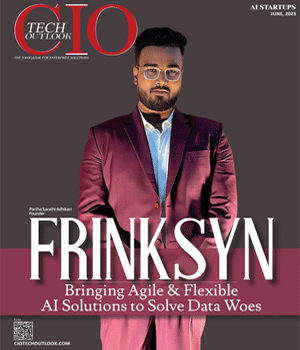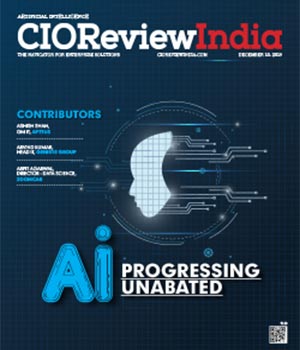
Conversational AI: The Key To Profitability
Somit Kapoor, Vice President and Global Head - Enterprise Operations Transformation (EOT), Wipro Ltd | Thursday, 06 August 2020, 11:42 IST

In an interaction with CIOReviewIndia, Somit Kapoor, Vice President and Global Head – Enterprise Operations Transformation (EOT), Wipro Ltd., shares his views on the current trends in Conversational AI, the factors which are driving its growth, and how it can be leveraged by businesses to improve profitability. Somit has over twenty years of diverse experience across digital, consulting, transformation, automation, operations, and technology solutions. With significant achievements at both strategic and tactical levels, Somit has led numerous multi-million dollar business units.
How has conversational AI technology grown over the years and how do you differentiate a “chatbot” from a “digital assistant”?
Chatbots are often highly specialized conversational agents that are frequently used for but are not limited to, text chat. They are functionally narrow in scope. In contrast, digital assistants are more capable conversational agents that are able to adapt to a broader interaction by natural language conversations rather than providing only information on certain queries. According to a Gartner report, by 2021, 15 percent of all customer service interactions globally will be handled by Artificial Intelligence.
This has been made possible with the advancement in Natural Language Processing, Machine Learning and Deep Learning. These technologies have enabled greater understanding of the user intent and have forayed into a “Digital Assistant” that can hold an end-to-end conversation. The growth from basic scripted chatbots to human-like advisors has been possible by incorporating not only the technologies mentioned, but also keeping the customer or the end user at the heart of the conversation. This makes it even more important to ensure that a sound customer experience strategy as well as appropriate content management and data analytics facilitates the right set of user insights. This can further develop not only the technology at play, but also provide insights on how to best utilize Conversational AI around the consumer touchpoints.
As organizational outcomes have driven the advancement in technology, omni-channel experience, self-service and real time personalization has the customer in mind when the product is created. The design outcome then shifts to more tangible aspects such as churn rate reduction and increased revenue when it concerns products generating predictive sales leads and automated knowledge base and content creation. Security and compliance are the other attached drivers towards product development when it concerns conversational AI.
“Every industry can and has leveraged conversational AI to improve their profitability, be it through better customer experience, higher customer retention or lower cost of operations”
What are the key trends that will be shaping the Conversational AI in the coming future?
Gartner predicted that 40 percent of virtual assistant applications launched in 2018 will have been abandoned by 2020 which points to the rapid development which is happening in this space. There are multiple reasons or trends which are helping that.
Firstly, leveraging low code/no code platform as well as open source coding of Conversational AI. This decreases the speed to market for a new product, and also incorporates product feedback/changes even before it is taken to the market.
Secondly, constant innovation to keep up with the increasing needs of the consumers with focus on personalization. User Interface and Augmented Reality will be crucial to make sure that the customer continues to return to the application, and enjoys utilizing it for day to day purposes.
Thirdly, Data and Behavioral Analytics will be extremely crucial to make sure that both tactical and strategic feedback is incorporated into the product while also ensuring that any hindrance to the adoption of the technology is prevented through appropriate governance.
Last one is the rising demand for convergence of applications having diverse characteristics within the conversational AI platforms. A single platform that can do a multitude of activities and tasks would automatically require not only creating a universal bot but also including features such multilingualism, voice etc.
“Although digital assistants were deployed in hr function long time ago, organizations are now realizing how it can work in tandem with the daily functions more efficiently and bring about unexplored benefits”
Which functions and industries are the forerunners in terms of Conversational AI adoption? What are the challenges when pitching the idea of adoption of this technology and what is the best strategy to overcome it?
Every industry can and has leveraged conversational AI to improve their profitability, be it through better customer experience, higher customer retention or lower cost of operations. From an organizational function perspective, currently the forerunners would be customer service, sales and Human Resources. These functions have the direct and most obvious correlation with revenue generation and customer experience.
There is also an increasing demand from finance, audit and procurement where Conversational AI can revolutionize how the end user in the organization interacts with machine. Employee experience is equally important as customer experience for any organization. Although, digital assistants were deployed in HR function long time ago, organizations are now realizing how it can work in tandem with the daily functions more efficiently and bring about unexplored benefits. This requires a skilled talent pool and organizational strategy to understand how digital assistants work and how they can be utilized to their full potential.
The main challenges when it comes to adoption are two, namely deployment cost and data security/ privacy. To overcome these barriers, organizations must craft the blueprint for Conversational AI adoption in a way that it maximizes efficiency. Their implementation partner must have an exhaustive playbook of the most relevant use cases which leverages gold standard transformation framework. Additionally, it is important to have a discussion on the art of possible and what kind of return to expect.
Conversational AI has a wide range of applications. How can a company leverage Enterprise Operations Transformation (EOT) framework towards implementation?
Conversational AI represents a manifestation of AI as a technology which in itself is a part of a larger set of technologies. Enterprise Operations Transformation (EOT) aims to leverage these technologies to digitally transform operations and maximize shareholder’s value. The unique aspect of EOT, when it comes to conversational AI solutions, is the largely product vendor-agnostic approach, made possible with alliances with leading product companies, upcoming platforms and strategic investment in various organizations. This will allow a partner to deliver a solution which is scalable, reliable, secure and easily integrated with legacy applications.
A prime example is virtual onboarding and training of new recruits which utilizes conversational AI and content management. A digital assistant can take care of virtual onboarding and orientation of resources along with having a natural conversation with the trainee queries. It will be able to capture concepts thoroughly and quickly and even provide insights by logging trainee performance into ERPs. This ensures immersive learning, improved training efficiency, improved employee experience and faster time to market.
The pandemic has caused businesses to change and adapt faster than before. Technology that provides us with a more efficient and intelligent way of doing things are now essential for operational continuity. Now more than ever, businesses need to look at redesigning operations and processes to leverage technology, to enhance efficiency, enabling remote operations, to streamline costs and also to deliver operational excellence and resilience. The developments and the transition of operating model has actually helped in making a case for adoption of conversational AI to maintain business operations in the most adverse time while not compromising on productivity and efficiency. The world continues to see an exponential demand for this technology both internally and with clients.
Disclaimer: "The views expressed in this article are mine and my employer does not subscribe to the substance or veracity of my views."
CIO Viewpoint
Why Foolproof Facial Recognition Is Key Against...
By Joseph Sudheer Thumma, Global CEO & MD, Magellanic Cloud
National Technology Day 2025: Powering Progress...
By CIOTech Outlook Team
Aligning IT Roadmap with Business Objectives: A...
By Subhash singh Punjabi, CISO & Head Enterprise Architecture, Deepak Fertilisers & Petrochemicals Corporation Ltd
CXO Insights
Data Management Strategies for AI-Driven...
By Dr. Parul Naib, Head - Data Science and AI, Reserve Bank Innovation Hub
Revolutionizing Financial Services with...
By Srikanth Appana, Chief Technology Officer, Bajaj Auto Credit Ltd
How to Lead Large-Scale Digital Engineering...









.jpg)
.jpg)
.jpg)









